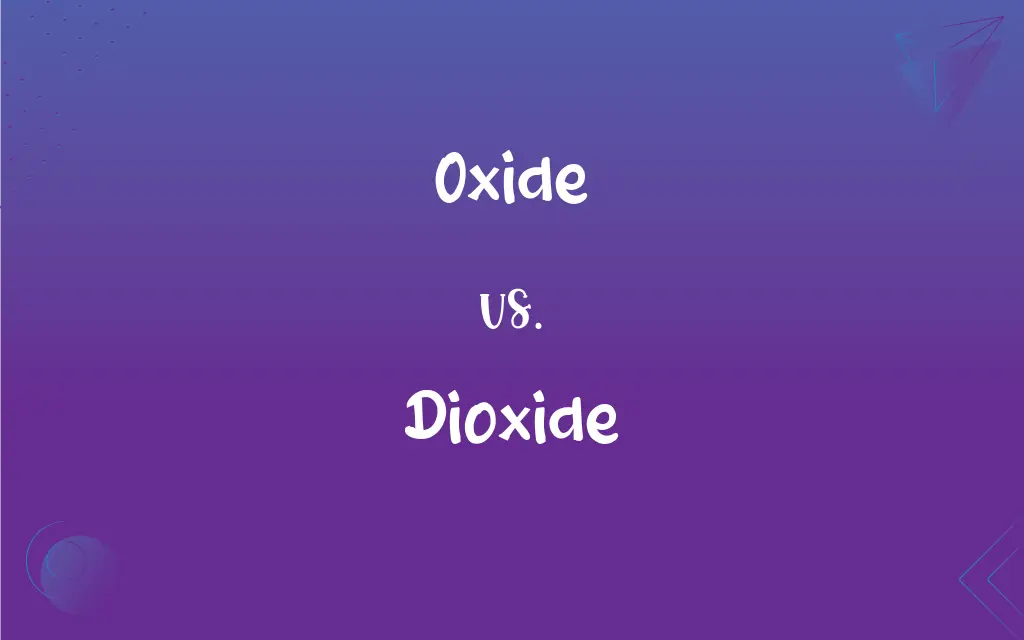Oxide vs. Dioxide: What's the Difference?
Edited by Aimie Carlson || By Harlon Moss || Published on January 27, 2024
Oxide is a chemical compound of oxygen with another element, while dioxide specifically refers to a compound with two oxygen atoms bonded to another element.

Key Differences
An oxide is a compound formed by the combination of oxygen with another element, displaying a variety of chemical properties. Dioxides are a specific type of oxide where the oxygen element is present in a ratio of two oxygen atoms for every other element.
Oxides can occur with different proportions of oxygen, not limited to any specific ratio. Dioxides, however, always maintain a stoichiometric ratio of two oxygen atoms to one of another element, as seen in carbon dioxide (CO₂).
In oxides, oxygen can bond with metals to form basic compounds, or with non-metals to form acidic compounds. Dioxides typically involve a covalent bonding of oxygen to another non-metal element, resulting in molecules like sulfur dioxide (SO₂).
Oxides are commonly found in nature as minerals and play significant roles in geological and biological processes. Dioxides are often found as gaseous components in the atmosphere, with carbon dioxide being a well-known example due to its role in climate change.
The reactivity of oxides depends on the nature of the element it is bonded to and the environmental conditions. Dioxides, given their specific oxygen-to-element ratio, have distinct chemical behaviors and applications, particularly in industrial and environmental contexts.
ADVERTISEMENT
Comparison Chart
Oxygen Content
Variable ratio
Always two oxygen atoms
Types of Bonds
Ionic or covalent
Predominantly covalent
Examples
Iron oxide (FeO), water (H₂O)
Carbon dioxide (CO₂), sulfur dioxide (SO₂)
Occurrence
Widespread in minerals, water
Common in atmosphere, combustion products
Chemical Behavior
Varies widely
Specific to two oxygen atoms
ADVERTISEMENT
Oxide and Dioxide Definitions
Oxide
An oxide is a compound of oxygen with another element or group.
Rust is an iron oxide formed by iron reacting with oxygen.
Dioxide
A dioxide is a compound containing two oxygen atoms bonded to another element.
Carbon dioxide is a greenhouse gas impacting Earth's climate.
Oxide
Oxides can occur naturally as minerals.
Silicon dioxide, found in quartz, is a major component of sand.
Dioxide
Dioxides often occur as gaseous compounds.
Sulfur dioxide is used in winemaking as a preservative.
Oxide
Oxides can be either ionic or covalent compounds.
Aluminum oxide is used as an abrasive due to its hardness.
Dioxide
Dioxides are important in various industrial processes.
Titanium dioxide is used as a pigment in paints and plastics.
Oxide
Oxides are commonly formed through the oxidation process.
Water, a common oxide, is essential for life.
Dioxide
Dioxides can be a product of combustion.
Burning fossil fuels releases carbon dioxide into the atmosphere.
Oxide
Metal oxides often exhibit basic properties.
Calcium oxide, also known as quicklime, reacts with water to form calcium hydroxide.
Dioxide
Some dioxides are critical for biological functions.
Plants use carbon dioxide for photosynthesis.
Oxide
Divalent anionic oxygen, or a compound of oxygen, especially a binary compound of oxygen with a more electropositive element.
Dioxide
A compound with two oxygen atoms per molecule.
Oxide
(chemistry) A binary chemical compound of oxygen with another chemical element. Category:en:Oxygen
Dioxide
(chemistry) Any oxide containing two oxygen atoms in each molecule.
Oxide
A binary compound of oxygen with an atom or radical, or a compound which is regarded as binary; as, iron oxide, ethyl oxide, nitrogen oxide, etc.
Dioxide
An oxide containing two atoms of oxygen in each molecule; binoxide.
Oxide
Any compound of oxygen with another element or a radical
Dioxide
An oxide containing two atoms of oxygen in the molecule
FAQs
Are all oxides harmful to the environment?
Not all oxides are harmful; their impact depends on the specific compound and its use.
What defines an oxide?
An oxide is a chemical compound of oxygen with another element.
Can oxides be naturally occurring?
Yes, many oxides like water and iron oxide occur naturally.
How does carbon dioxide affect global warming?
Carbon dioxide is a greenhouse gas that contributes to global warming.
Are oxides used in industry?
Yes, oxides like aluminum oxide are used in various industrial applications.
Do oxides play a role in corrosion?
Yes, some oxides, like rust, are products of the corrosion process.
What makes a compound a dioxide?
A dioxide contains exactly two oxygen atoms bonded to another element.
Is sulfur dioxide dangerous?
Sulfur dioxide can be harmful, especially to the respiratory system.
What role does dioxide play in the atmosphere?
Dioxides like carbon dioxide are key components of the Earth's atmosphere.
Are dioxides always harmful when inhaled?
Inhaling certain dioxides can be harmful, but it depends on the compound and concentration.
How does dioxide contribute to the greenhouse effect?
Dioxides like carbon dioxide trap heat in the Earth's atmosphere, contributing to the greenhouse effect.
Can oxides form acids or bases?
Yes, oxides can form acids or bases depending on the bonded element.
Are all oxides solid at room temperature?
No, oxides can exist in various states depending on their composition.
How are oxides formed?
Oxides are formed through the chemical reaction of oxygen with other elements.
Can oxides be both natural and synthetic?
Yes, oxides can be found in nature or synthesized for specific purposes.
Can dioxide be a component of air pollution?
Yes, dioxides like sulfur dioxide can contribute to air pollution.
Is dioxide always a gas?
No, dioxides can be gases, solids, or liquids, depending on the compound.
What is the significance of water being an oxide?
Water as an oxide is essential for life and involved in many chemical reactions.
Is titanium dioxide safe in consumer products?
Titanium dioxide is generally considered safe in consumer products like cosmetics and paints.
Do dioxides have industrial uses?
Yes, dioxides like titanium dioxide are widely used in industries like paint and paper.
About Author
Written by
Harlon MossHarlon is a seasoned quality moderator and accomplished content writer for Difference Wiki. An alumnus of the prestigious University of California, he earned his degree in Computer Science. Leveraging his academic background, Harlon brings a meticulous and informed perspective to his work, ensuring content accuracy and excellence.
Edited by
Aimie CarlsonAimie Carlson, holding a master's degree in English literature, is a fervent English language enthusiast. She lends her writing talents to Difference Wiki, a prominent website that specializes in comparisons, offering readers insightful analyses that both captivate and inform.







































































